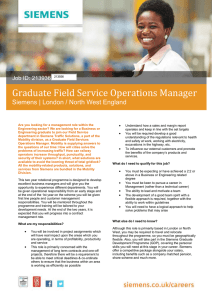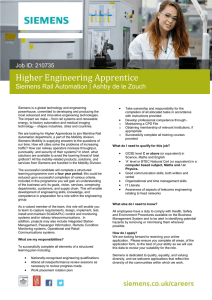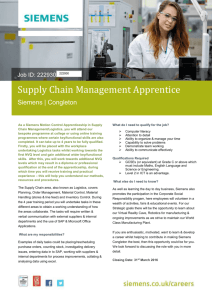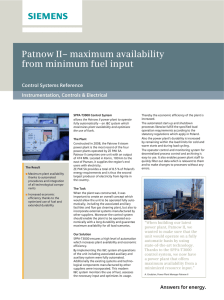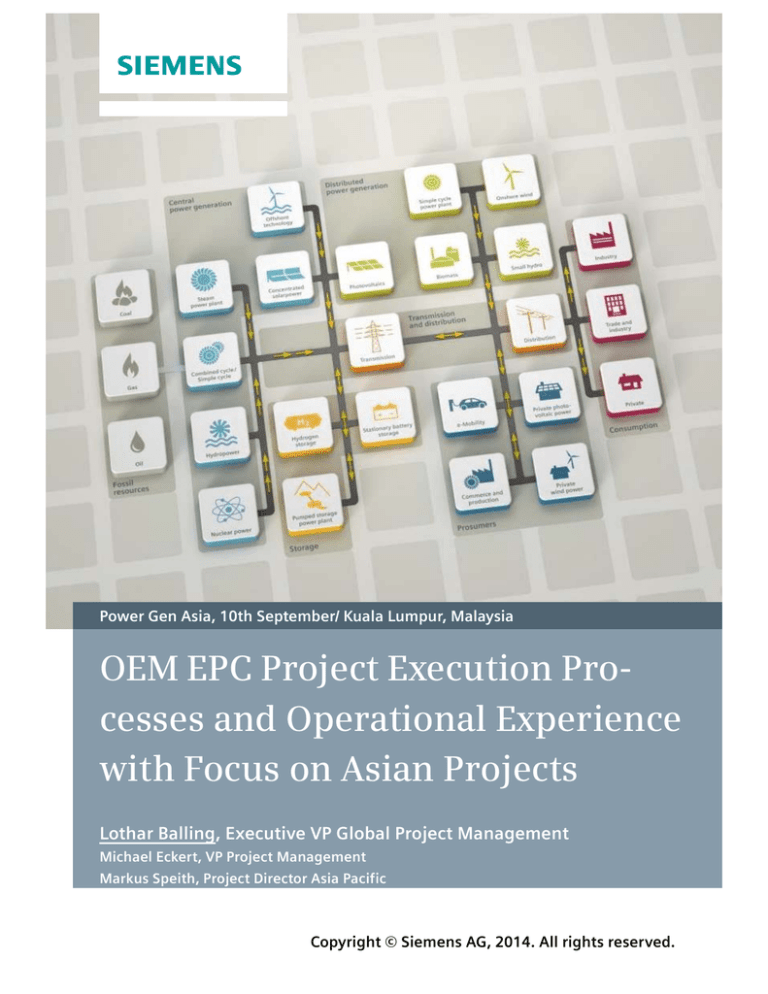
Power Gen Asia, 10th September/ Kuala Lumpur, Malaysia
OEM EPC Project Execution Processes and Operational Experience
with Focus on Asian Projects
Lothar Balling, Executive VP Global Project Management
Michael Eckert, VP Project Management
Markus Speith, Project Director Asia Pacific
Copyright © Siemens AG, 2014. All rights reserved.
Power Gen Asia, 10th September/ Kuala Lumpur, Malaysia
1. Introduction
Gas combined cycle power plants (CCPPs) are playing a vital role in the energy supply since
its major commercial introduction in the 70th. Due to its clean operation with nearly no SO2,
no dust, indelible NOX emissions, low CO2- emissions, the short construction time and the
wide availability of gas CCPPs penetrated the markets also mainly in Asia since the 70th as
well.
The future market share of gas fired plants is further improving from today to 2020 especially
in Asia along with total growth of installed base (Fig. 1). Total global installed based is growing from 2013 to 2020 by 24%, where Asian base growths by 32% and gas fired plants in
Asia by 27% or about 10 GW/a.
Fig. 1: Market development World Wide and Asia
Recent executed projects in Middle East like in Oman and Asia like in Singapore, Thailand,
Vietnam and Korea are showing the interest of utilities and IPPs in these types of plants (Fig.
2). The major success factors where:
- short development and construction schedule compared to other fossil and nuclear plants
- negligible emissions in terms of SOx, CO, NOx, dust and least CO2- emissions of all fossil
plants
- least water use, down to zero with special technology (Zero Discharge, ACC…)
- wide availability of gas (pipe gas, LNG, waste gas…)
Due to increasing gas prices recent new orders in Middle East and Asia like in Korea and Malaysia show, that more focus is given to efficiency and new technology like H- class CCPP
technology is getting more and more market share. The recent orders in Korea, Thailand and
Malaysia are demonstrating the superior advantage of this type of plants in single- or multishaft design also in South East Asia.
Copyright © Siemens AG 2014. All rights reserved.
2
Power Gen Asia, 10th September/ Kuala Lumpur, Malaysia
Fig. 2: Examples of recent Turnkey successes in Middle East/ Asia
2. Project Management
The technical and commercial success of all these projects are mainly based on the engineering and project management capability in order to design an highly efficient, reliable, value
for money power plant concept and execute it in time, budget, quality and without incidents.
Due to this reason project management has since beginning a very high status internally as
this was and is always the basis for successful project business (Fig. 3).
Fig. 3: History of Project Management
Copyright © Siemens AG 2014. All rights reserved.
3
Power Gen Asia, 10th September/ Kuala Lumpur, Malaysia
3. Processes
In order to establish a project centric organization, Siemens had been starting to develop a centralized
process in the year 2000 derived out of best practice from the power plant solution business. Since the
team has optimized and developed the process further and since 2009 mandatory elements like project
categorization, training and certification are mandatory in all Siemens project business.
The very well structured process is covering the whole process steps from early market screening over
bidding, negotiation, execution, warranty and service of the respective scope.
This milestone driven process is also integrating quality milestones, reviews and releases in order to
allow a proper monitoring and quality management (Fig. 4).
Fig. 4: PM @ Siemens, a Standard Processes also for excellent project execution
Since the late 90th the project management capability development and assessment had
been improved further leading to an optimized process for the development and certification
of professional project managers (Fig. 5). Since introduction of our PM@Siemens academy
and qualification/ certification process in 2009 Siemens has developed about 40
professional high grade project managers for our most critical power projects with an
average age of 52 years and an experience of more than 11 years as project managers.
Copyright © Siemens AG 2014. All rights reserved.
4
Power Gen Asia, 10th September/ Kuala Lumpur, Malaysia
Fig. 5: Project management career
4. Challenges
A fundamental precondition of a successful power plant and infrastructure project execution
is the project schedule integrated with a resource plan, historic comparison and the contractual
milestones (Fig. 6).
A typical power plant schedule will be broken down to 3 levels with a total number of 50008000 activities which need to be adopted, tracked and revised on a continuous basis. A regular
monthly critical path analysis is supporting a very transparent process and risk assessment for
the individual packages and systems as well an assessment of resources and performance of
teams, subcontractors and partners.
Fig. 6: Fully Integrated Scheduling allows flawless Progress Monitoring
Copyright © Siemens AG 2014. All rights reserved.
5
Power Gen Asia, 10th September/ Kuala Lumpur, Malaysia
The development of a shortest possible but reliable schedule is always the focus of a good
EPC in order to reduce base costs and increase the value generation towards their
customers.
This exercise however is based on a vast experience and feedback from executed projects
and further optimization based on a construction driven concept and considering the local
conditions, the technology and supply schedule of key OEM equipment and suppliers. As
these conditions are changing, an updated reference schedule concept is important to be
quickly able to offer the best, however reliable schedule considering penalties releated to
potential delays.
For a single GT power plant with 400-600 MW we are today striving for a schedule in the
range of 2 years depending on boundary conditions like input dates from customers,
environmental factors etc. Fig. 7 shows that we have successfully managed such short track
projects in all areas of the world and also recently again in Asia with the Andong Single
Shaft 8000H project together with our customer and partner.
Fig. 7: Today individual power plants can be delivered in record time
Beside all of the good processes in terms of schedule and quality, another factor is playing a
more and more vital role during construction and operation: the protection of the environment
as well as the health and safety of the people involved.
There is a clear connection to be seen between an efficient run construction site and the safety
behavior of the people involved.
Over the past 5 years a Zero Harm mindset initiative started to be developed mainly together
with concerned utilities and IPPs in Europe, as well as with global Oil and Gas customers
who are also heavily affected by public awareness and internal quality targets. For the management of an improvement by a factor 5 a special culture needs to be developed not only by
an instruction from Top Management, but by achieving the engagement and buy in of all employees involved in the process (Fig. 8).
Copyright © Siemens AG 2014. All rights reserved.
6
Power Gen Asia, 10th September/ Kuala Lumpur, Malaysia
Fig. 8: Environment, Health and Safety
Meanwhile the concept of Zero Harm
• We take care of each other
• Zero incidents - it is achievable
• Health and safety - no compromises
Was rolled out to all sites and the achievements are obviously and recognized already with
international awards:
- Severn Power UK 2010: DONG and NJC (UK) award for 3’ man hour w/o incident
- Unosugen India 2013: NSC award
- Island Power Singapore 2013: SHARP award for >1’ man hours w/o incident
- Tuasspring Singapore 2014: SHARP award for >1’ man hours w/o incident
Many other plants like Chana/ WangNoi in Thailand, Shuweihat S3 in Abu Dhabi, and La
Caridad in Mexico are demonstrating that ZeroHarm is achievable (Fig.9).
Copyright © Siemens AG 2014. All rights reserved.
7
Power Gen Asia, 10th September/ Kuala Lumpur, Malaysia
Fig. 9: Numerous recent Power Plant Projects without any Lost Time Injury (07/2014)
5. Solutions
In order to support the commercial success of a today’s power plant, not only first time costs
have to be considered.
The economics of a power plant is based on a complex algorithm which is fed by three main
inputs:
- Operating Costs
- Plant Performance
- Financing Costs
Today the economics of power plants are under tremendous pressure due to its global competition in liberalized markets and it is no wonder that utilities and IPPs are striving always for
lower levelized electricity costs.
An OEM EPC has the unique opportunity to support the optimization of many of these features. By applying most innovative technology into the main equipment, the balance of plant,
the process and I&C technology, the plant can be made more viable and attractive to insurer,
banks, shareholders, community and end customers (Fig. 10).
Copyright © Siemens AG 2014. All rights reserved.
8
Power Gen Asia, 10th September/ Kuala Lumpur, Malaysia
Fig. 10: Economical Key Factors for Competitiveness
Further challenges in this market are the new upcoming supplier requirements to keep up with
the global competition out of low cost countries in order to reach this required competitive
price level without hampering quality and reliability.
In order to support the utilities and IPPs further with a globally competitive price level, the
traditional suppliers need to be challenged and a new supplier base from low cost areas need
to be developed.
In order to maintain a reliable and quality based supply chain, the quality processes need to be
adopted and intensified.
More focus has to be given to the following areas:
- Design to cost measures with existing suppliers
- Exploration of new suppliers with a lower cost structure
- Development of capabilities for the international market (e.g. quality management)
- Qualification and Lessons Learnt process
- Development and application of a rigorous expediting process
Therefore an integrated and long term focused quality process is a key to maintain highest
quality as EPC contractor (Fig. 11).
This process needs to be started well ahead of a bidding process for a specific project, but
needs to be focused on strategic areas and scope in order to avoid delays and unpleasant experience.
Copyright © Siemens AG 2014. All rights reserved.
9
Power Gen Asia, 10th September/ Kuala Lumpur, Malaysia
Fig. 11: Quality Management and Expediting, essential element of an EPC process
In order to make use of the vast experience being developed over the executed projects a Lessons Learnt process imbedded in the organization is important in order to reduce nonconformance costs (NCCs) and improve from one project to the other in terms of quality, schedule, costs and customer satisfaction.
To maintain such a process sustainable, the following preconditions are required:
- Motivate all project participants in order to feed this process continuously and in a
timely manner
- Analyze and provide essentials out of the input quickly
- Make the experience and the actions easy available to the people involved
Fig. 12: Continuous improvement process in project business ensures future success
Copyright © Siemens AG 2014. All rights reserved.
10
Power Gen Asia, 10th September/ Kuala Lumpur, Malaysia
With the development of Information Technology, Hardware and Know How, Siemens contrived a next generation of a documentation system allowing to supply all OEM, but also main
equipment documents fully electronically and “intelligent” in order to allow the operators to
have the essential information on the finger tips quickly, efficient and easily updated. The
basis for this new Operating Guidance System “D- View” has been applied in the project
Knapsack Germany for the first time also with the use of Tablet PCs and wireless connection
to the main system to make use of this system also in the field (Fig. 13).
Fig. 13: Innovative Documentation Intelligently linked, dynamically stored
All above proven processes and technologies are the basis for a successful execution of a
challenging CoGen project like the 1200 MW Pengerang with 4 SGT5-8000H, 4 HRSGs, 2
steam turbines and massive steam production of more than 1400 t/h in order to supply the
facilities of the Refinery And Petrochemicals Integrated Development (RAPID) down south
of Malaysia.
The project had been awarded to Siemens Power and Gas, Energy Solution on Turnkey basis
together with the consortium partner MMC ES by PETRONAS Sdn Bhd in June 2014 and is
now in full swing of engineering and preparation of the construction site. First power and
steam are targeted to be delivered in June 2017 and finalized with the RAPID progress early
2019.
Copyright © Siemens AG 2014. All rights reserved.
11
Power Gen Asia, 10th September/ Kuala Lumpur, Malaysia
Fig. 14: Pengerang (Petronas) in Malaysia a project with the need of execution excellence
6. Summary
The best and most experienced project manager alone cannot solve all the challenges faced by
a challenging EPC project. He needs organizational, process and tool support in order to apply
his skills effectively.
Only the consistent application of a power plant engineering, procurement, construction and
management process is the basis of a successful EPC business model. The use of most modern IT technologies and tools can support the speed and quality of execution.
Such a process also needs to integrate a supplier qualification and development process as
well as Lessons Learnt and a continuous improvement process.
Siemens Power and Gas Solutions has developed and applied best practice processes and
tools in the last years in order to improve its execution quality and to reduce execution time
while maintaining high EHS standard to return a benefit to the utilities and IPPs served.
Copyright © Siemens AG 2014. All rights reserved.
12
Power Gen Asia, 10th September/ Kuala Lumpur, Malaysia
Disclaimer
These documents contain forward-looking statements and information – that is, statements related to
future, not past, events. These statements may be identified either orally or in writing by words as
“expects”, “anticipates”, “intends”, “plans”, “believes”, “seeks”, “estimates”, “will” or words of similar meaning. Such statements are based on our current expectations and certain assumptions, and are,
therefore, subject to certain risks and uncertainties. A variety of factors, many of which are beyond
Siemens’ control, affect its operations, performance, business strategy and results and could cause the
actual results, performance or achievements of Siemens worldwide to be materially different from any
future results, performance or achievements that may be expressed or implied by such forward-looking
statements. For us, particular uncertainties arise, among others, from changes in general economic and
business conditions, changes in currency exchange rates and interest rates, introduction of competing
products or technologies by other companies, lack of acceptance of new products or services by customers targeted by Siemens worldwide, changes in business strategy and various other factors. More
detailed information about certain of these factors is contained in Siemens’ filings with the SEC,
which are available on the Siemens website, www.siemens.com and on the SEC’s website,
www.sec.gov. Should one or more of these risks or uncertainties materialize, or should underlying
assumptions prove incorrect, actual results may vary materially from those described in the relevant
forward-looking statement as anticipated, believed, estimated, expected, intended, planned or projected. Siemens does not intend or assume any obligation to update or revise these forward-looking statements in light of developments which differ from those anticipated.
Trademarks mentioned in these documents are the property of Siemens AG, its affiliates or their respective owners.
Copyright © Siemens AG 2014. All rights reserved.
13





